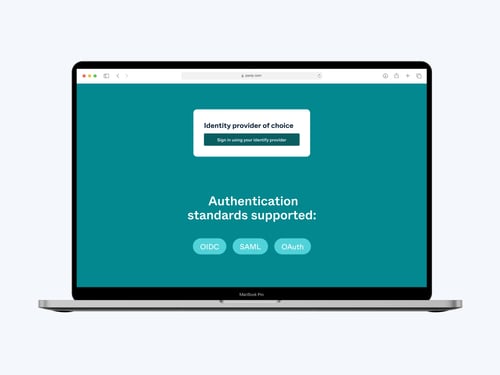Why interoperability is essential for modern video conferencing.
Many organizations have invested significantly in video conferencing technology and advanced video equipment to enhance their meeting rooms. These meeting rooms have served as communication hubs, sparking greater productivity and enabling everyone to work across locations and borders.
Today, video meetings have become the norm for collaboration, and thanks to the advent of software-based video solutions, such as Teams or Zoom, just about any device can connect to your colleagues worldwide.
One key challenge has arisen in the era of global connectivity, in which anyone can reach anyone anytime, anywhere.
Not everyone is using the same video conferencing platforms or equipment. Multiple solutions are available to users, and it’s not always one-size-fits-all. Sometimes, these software platforms don't work natively with the existing meeting room equipment, which can frustrate users.
The leading player in the global collaboration market is Teams, the renowned Microsoft product that has found its way to laptops and mobile devices everywhere. Zoom and Google Meet are also widely embraced and much loved for their user-friendly features.
In addition, many companies outfit their meeting rooms with high-quality hardware from Poly or Cisco Webex. In today's hybrid work environment, using multiple video solutions within an organization is normal, adding to the complexity when users want to connect using their preferred meeting solutions and meeting rooms.
More about video conferencing interoperability technology
Interoperability is all about making multiple video systems work seamlessly together.
Since organizations may have several video conferencing room devices simultaneously, they need a solution to make them work seamlessly. This is interoperability in practice.
Any-to-any approach to video conferencing
Video interoperability technology can be the much-needed bridge between video meeting solutions and video conferencing equipment in meeting rooms everywhere.
Key benefits of interoperability
Ease of use
Interoperability ensures less complexity for the end-user so they can join any meeting from any room without hassle. The experience remains familiar. No training is required. And they can focus on the meeting at hand rather than figuring out the technology.
Simply better meetings
Interoperability brings technologies together so that everyone, no matter where they’re joining from, can share the same high-quality video meeting experience.
Future-proofed experience
Get the latest software and video meeting experiences, even on older video systems – and put a stop to the ‘rip and replace’ cycle. Ensure your organization is always ready to adapt to the next video meeting solution, making it work efficiently with any existing endpoints.
Three signs that your organization needs
an interoperability platform:
- You have many meeting rooms with video conferencing equipment from various manufacturers, such as Poly and Cisco Webex.
- Your organization uses video meeting solutions on personal devices like Teams, Zoom, and Google Meet. Perhaps you’ve even added Teams Rooms and Zoom Rooms to your office space.
- You need more flexibility in your meeting rooms (a combination of technologies and vendors in your environment), and you don’t want to toss out your costly meeting room equipment. You require a solution enabling any of your meeting room devices to join any video meeting solution seamlessly.
The future of interoperability.
The need for interoperability isn’t going away anytime soon.
All meeting rooms are different, with varying requirements and features – from platform selection to vendor options to specific room requirements and user expectations for the room. Interoperability allows organizations to outfit that room with the right video technology to suit their meeting room.
New video solutions will continue emerging, and meeting rooms everywhere must be ready.
There’s certainly no shortage of video meeting solutions on the market today. This means that organizations will continue to need a way to connect all types of digital meetings to physical meeting rooms regardless of the equipment in the room. They also need to ensure that service-specific endpoints, such as a Teams Room, Google Meet Room, or Zoom Room, can still connect to other types of meetings—even meeting solutions that don’t yet exist!
Direct calling from service-based rooms to other types of meetings will grow more relevant.
More meeting rooms are outfitted with custom equipment from the video meeting vendor, such as Teams Rooms. Ensuring that any room can call any meeting and any room can call any room is at the heart of what interoperability does for organizations.
Key priorities when selecting a video interoperability solution
Privacy and security top the priority list
Compliance requirements are increasing in most organizations today due to the increasing number of cyber threats and the strict regulations around data protection and privacy. Organizations will place higher expectations on their video technology vendors to ensure that their standards are met and maintained and that the vendor complies with current and emerging regulations.
More focus on privacy and security around AI
AI is already broadly used to enhance video meetings. Privacy and security-conscious organizations will aim to ensure the secure provisioning of AI features in their video technology, such as voice-to-voice translation. This will require video vendors to ensure privacy and security around AI data to stay compliant and meet customer requirements.
Increasing customization expectations
Organizations are diverse in size, composition, and needs. As video has become a mainstay in communication and collaboration, IT departments will grow in their expectations for video technology providers. Scalability, ease of integration, and ability to customize to suit an organization’s unique expectations will be essential.
Deep Dive into Teams interoperability: A look at Microsoft’s CVI Program
Cloud Video Interoperability, or CVI, is a Microsoft Certification Program for integrating and communicating between Teams and non-native Teams devices.
The CVI program allows SIP and H.323 video systems to join Teams meetings. Microsoft developed it and has significantly invested in it to ensure a seamless experience for users no matter how they want to join their Teams meetings. They work closely with the CVI-approved vendors to innovate and guarantee optimal end-user experience and support.
Pexip sets the record straight about CVI for Teams
Why do you need an interoperability partner when you have Teams?
Ensure return on investment.
Customers need an interoperability solution because they want to leverage their existing and costly assets in the meeting rooms now that they have moved to Teams.
Get more flexibility
Organizations need to support their existing meeting rooms, and/or they want to add some Teams rooms to the office landscape. Another scenario could be that they will merge with another organization, resulting in mixed meeting vendor environments.
Support Multiple Meeting Platforms
Many organizations support more than just Teams and often have upwards of 3 meeting services their users leverage, which means they need interoperability to meet the needs of their internal users.
How to choose an interoperability provider for Teams
Organizations should consider key factors when evaluating interoperability vendors to ensure optimal functionality and seamless connectivity between disparate systems.
Certified interoperability provider
Investigate whether the interoperability provider is certified by Microsoft. Selecting a certified or recognized interoperability provider to Microsoft (as part of Microsoft’s CVI program) can offer many benefits, including support from both Microsoft and the interoperability provider if issues arise.
The power of being Microsoft-certified
Accessible in Azure Marketplace
When buying through Azure Marketplace, customers benefit from standardized procurement contracts covered by their existing agreements with Microsoft. About 95% of Fortune 500 companies use Microsoft Azure and can procure solutions via the Marketplace.
Ease of deployment
When selecting an interoperability provider, ensure that it offers straightforward deployment processes and management tools so your IT team can easily set it up and maintain it as part of your communications and collaboration ecosystem.
Quality of service
Assess whether the interoperability provider offers high-quality audio and video streaming so that your meeting participants enjoy almost as well as in-person meetings.
Market position
Evaluate the interoperability provider’s partner status with Microsoft and its current customer base to ensure a solid market position and a strong reputation for superior technology.
Security and Compliance
Organizations increasingly prioritize privacy and security, so evaluating how the interoperability provider protects data and remains compliant is essential.
Overview of the Microsoft interoperability market today
The Microsoft Teams interoperability market has grown more condensed in recent years. BlueJeans by Verizon is sunsetting its interoperability product, and Poly is partnering with Pexip to power its Poly CloudConnect product.
Currently, two vendors are offering Microsoft-certified interoperability through CVI integration as a cloud service: Pexip and Cisco.
Pexip
Pexip is a Microsoft-certified CVI partner with a FedRAMP-authorized solution. As a trusted and preferred Microsoft independent Software Vendor (ISV), customers can rest assured that the product is vetted and validated by Microsoft solution experts.
Pexip provides the most Teams-like experience for video conferencing devices. Pexip supports various vendors and devices, including multiple generations of those devices, resulting in great flexibility as your meeting room requirements evolve.
Pexip offers SIP Guest Join, a technology that enables users to join Microsoft Teams and Google Meet meetings outside their company via their existing meeting endpoints – in just one click.
Join any Teams meeting on any device: Introducing SIP Guest Join
Pexip interoperability enables direct calling from Teams Rooms to any other meeting service, unlocking the meeting possibilities for these service-based rooms. Pexip is also doing this for Zoom and Google Rooms!
Cisco Webex
Cisco Webex Video Integration enables users of Cisco Webex Room or other SIP devices to join video meetings from Teams and other video meeting providers.
Poly CloudConnect
When Poly announced the end-of-life of its CVI product in 2023, the company entered a strategic partnership with Pexip. Now, Pexip’s technology is integrated into Poly’s solutions to ensure a seamless video experience for users on any video meeting platform.
Pexip Partners with Poly to Expand Secure Video Collaboration
Other vendors
Blue Jeans has sunset its offering. Other vendors, such as Synergy Sky, offer standards-based interoperability solutions with Teams from SIP-based systems. However, they are not part of the Microsoft CVI program.
Read more about the Microsoft CVI program here.
Interop 2.0: the future of the interoperability market
Technology will continue to move forward, and there will always be the next best thing. This gives us amazing opportunities to advance and presents new challenges. The latest and greatest must inevitably work within the existing business landscapes.
And it’s in bridging this gap that interoperability does and continues to play a vital role.
For all types of organizations, maximizing return on investment (ROI) on existing technologies will be essential even as they embrace the new. Interoperability solutions enable this.
This was the motivation behind Microsoft’s CVI program, a way to ensure existing SIP/H.323 systems connect to Teams meetings, thus enabling customers to maximize ROI.
Now, we see increasing platform-specific devices entering the landscape, such as Team Rooms and Zoom Rooms. These rooms must connect with customers’ existing investments in meeting equipment – whether to their internal meeting rooms and devices or external parties using different systems and solutions.
Pexip takes an any-to-any approach to a video meeting.
Our goal at Pexip is to make meetings hassle-free for everyone. We believe that users should be allowed to focus on the business and not worry about the technology powering their meetings.
Interop 2.0 at Pexip is about creating seamless meeting experiences based on our any-to-any approach. This means that with Pexip, users can connect any room to any device and vice versa – now and in the future.
Integrating Microsoft Teams with Pexip Infinity
Infinity 33 introduces breakout rooms and AI features
- Connect

.jpg?width=700&name=Blog%20(1).jpg)

.jpg?width=500&name=policy%20server%203%20(1).jpg)

